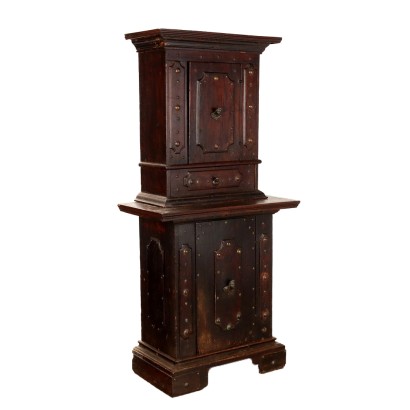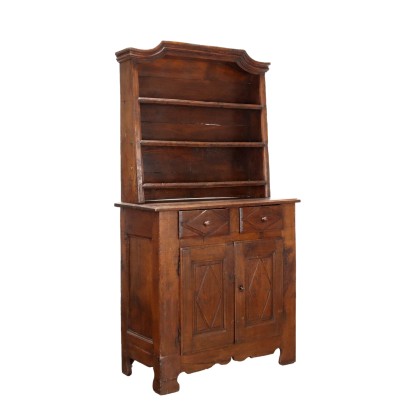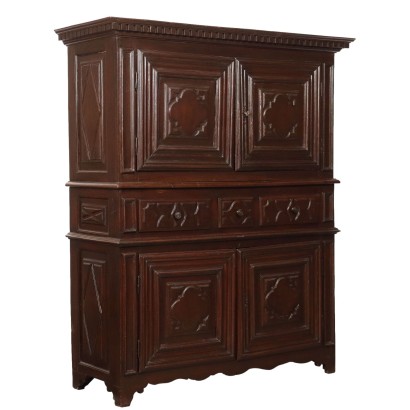Antique Neo-Baroque Cupboard Silver Fir Italy XIX Century - Emilia Romagna, Late XIX Century
Features
Emilia Romagna, Late XIX Century
Style: Neo-Baroque (1860-1890)
Age: 19th Century / 1801 - 1900
Origin: Emilia Romagna, Italy
Main essence: Silver Fir , Walnut , Poplar
Material: Brass
Description
Cupboard with neo-Baroque walnut wall unit, Emilia Romagna late 19th century. The wall unit, with a door and drawer on the front, is made from antique parts, while the sideboard, with a front door opening, was obtained by modifying an older piece of furniture. Brass studs.
Product Condition:
Product that requires restoration and polishing due to age and wear. We try to present the actual state of the furniture as fully as possible with photos. Should certain details not be clear from the photos, the description shall prevail.
Dimensions (cm):
Height: 180
Width: 86,5
Depth: 45
Additional Information
Style: Neo-Baroque (1860-1890)
Anticipated in England in the first half of the 19th century on the reminiscences of the Elizabethan style, it came back into fashion around 1870, but interpreted in a very free way.It initially represents a response to the frivolity of neo-Rococo, but soon lapses into a pompous and eclectic style that combines severe sixteenth-century elements with sculptural decorations from the early 17th century.
The furniture is solid, richly carved and carved, in dark patina wood.
Garnets, frames, columns carved with herms that make up architectural structures typical of Renaissance palaces, are the elements that characterize the neo-Renaissance style.
It was an era in which we saw the revival and re-proposal of ancient forms with a typically Renaissance taste, large carvings were used for a more complete, deeper and three-dimensional vision, the use of animal paws in chests and wardrobes, squares and moldings, frames, bossages and claws, Romanesque ornamental motifs but also acanthus leaves, cartouches and lion heads.
Often in this period, furniture was built using ancient materials and parts of Renaissance furniture.
Walnut was often used but also less hard essences such as poplar or others since they were often darkened and presented in black.
Find out more with the insights of our blog:
The Neobaroque in a large 19th century table
INSERT ADDITIONAL LINKS
Austrian taste for Baroque
Rococo style in Italy
The Renaissance and its impact on design
Age: 19th Century / 1801 - 1900
19th Century / 1801 - 1900Main essence:
Silver Fir
Soft coniferous wood, used for rustic furniture or to build the chest, that is the structure, of furniture then veneered in more precious woods. It has been used since ancient times, its most valuable use is, in the Spruce variant, in the inlays of French antique furniture of the '700 . The spruce, more typical of northern Europe, in Italy grows mainly in the Eastern Alps at altitudes above 1300 m. The noblest use of this essence was in the construction of violins, guitars and cellos: Stradivari himself produced his famous violins with this wood.Walnut
Walnut wood comes from the plant whose botanical name is juglans regia , probably originally from the East but very common in Europe. Light or dark brown in color, it is a hard wood with a beautiful grain, widely used in antique furniture. It was the main essence in Italy throughout the Renaissance and later had a good diffusion in Europe, especially in England, until the advent of mahogany. It was used for solid wood furniture and sometimes carvings and inlays, its only big limitation is that it suffers a lot from woodworm. In France it was widely used more than anything else in the provinces. In the second half of the eighteenth century its use decreased significantly because mahogany and other exotic woods were preferred.Poplar
Essence considered "poor", it is a white wood, with yellowish or greyish shades, light and tender, which is easily damaged. It is used for rustic furniture or in the construction of furniture. The most valuable use it has had in the history of furniture is in Germany, in the 19th century, for veneers and inlays in the Biedermeier period.Material: Brass
Other customers have searched:
Ecco qualche spunto dal nostro blog e da FineArt per scoprire di più sul tema credenze:
Leggi di più
Una credenza che dialoga con il passatoCredenza doppio corpo, tesoro di intagli e decorazioni
Piccolo stipo, grande arredo
Stipo toscano a cavallo tra XVI e XVII
Credenza Barium di Luciano Frigerio
Credenza, Mathieu Befort Jeune, Parigi, terzo quarto XIX secolo
Mobile anni '60
Highboard '503' Gianfranco Frattini per Bernini
Mobile bar anni '40
Mobile Bar anni '40 '50, manifattura italiana
Sull'antiquariato in generale dai un'occhiata anche a:
Classic Monday: da un pezzo dei nostri magazzini alla storia dell'antiquariato
L'antiquariato dalla A alla Z: il Dizionario dell'Antiquariato
Il dizionario dell'antiquariato - Lastronatura
Il dizionario dell'antiquariato - Mascherone
Il dizionario dell'antiquariato - Natura morta
Il dizionario dell'antiquariato - Opificio
Il dizionario dell'antiquariato - Pastiglia
Il dizionario dell'antiquariato - Savonarola
Il dizionario dell'antiquariato - Rosone
Product availability
The product can be seen at Cambiago
Immediate availability
Ready for delivery within 2 working days from ordering the product.















































